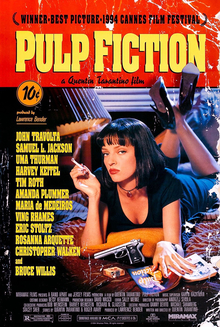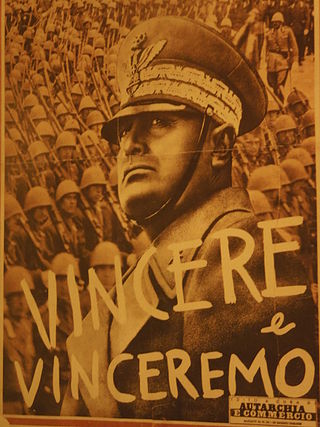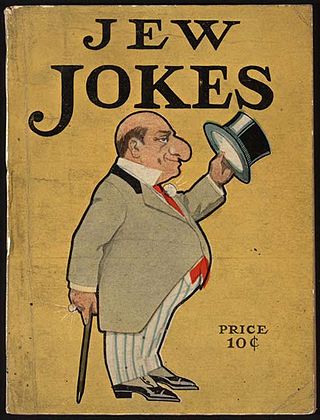Related Research Articles

Film noir is a cinematic term used primarily to describe stylized Hollywood crime dramas, particularly those that emphasize cynical attitudes and motivations. The 1940s and 1950s are generally regarded as the "classic period" of American film noir. Film noir of this era is associated with a low-key, black-and-white visual style that has roots in German Expressionist cinematography. Many of the prototypical stories and attitudes expressed in classic noir derive from the hardboiled school of crime fiction that emerged in the United States during the Great Depression.

Fascism is a far-right, authoritarian, ultranationalist political ideology and movement, characterized by a dictatorial leader, centralized autocracy, militarism, forcible suppression of opposition, belief in a natural social hierarchy, subordination of individual interests for the perceived good of the nation and/or race, and strong regimentation of society and the economy.

Pulp Fiction is a 1994 American independent crime film written and directed by Quentin Tarantino from a story he conceived with Roger Avary. It tells four intertwining tales of crime and violence in Los Angeles, California. The film stars John Travolta, Samuel L. Jackson, Bruce Willis, Tim Roth, Ving Rhames, and Uma Thurman. The title refers to the pulp magazines and hardboiled crime novels popular during the mid-20th century, known for their graphic violence and punchy dialogue.

Charles Michael "Chuck" Palahniuk is an American novelist who describes his work as transgressional fiction. He has published 19 novels, three nonfiction books, two graphic novels, and two adult coloring books, as well as several short stories. His first published novel was Fight Club, which was adapted into a film of the same title.
Sissy, also sissy baby, sissy boy, sissy man, sissy pants, etc., is a pejorative term for a boy or man who does not demonstrate masculine traits, and shows possible signs of fragility. Generally, sissy implies a lack of courage, strength, athleticism, coordination, testosterone, male libido, and stoicism. A man might also be considered a sissy for being interested in typically feminine hobbies or employment, displaying effeminate behavior, being unathletic or being homosexual.

Masculinity is a set of attributes, behaviors, and roles associated with men and boys. Masculinity can be theoretically understood as socially constructed, and there is also evidence that some behaviors considered masculine are influenced by both cultural factors and biological factors. To what extent masculinity is biologically or socially influenced is subject to debate. It is distinct from the definition of the biological male sex, as anyone can exhibit masculine traits. Standards of masculinity vary across different cultures and historical periods.

Fight Club is a 1999 American satirical black comedy psychological thriller film directed by David Fincher, and starring Brad Pitt, Edward Norton and Helena Bonham Carter. It is based on the 1996 novel by Chuck Palahniuk. Norton plays the unnamed narrator, who is discontented with his white-collar job. He forms a "fight club" with soap salesman Tyler Durden (Pitt), and becomes embroiled in a relationship with an impoverished but beguilingly attractive woman, Marla Singer.

The buddy film is a subgenre of romantic comedy, a combination of the romance, adventure and comedy film in which two people, bonded through some kind of affection or love for each other, go on an adventure, mission, or road trip. The two typically are males with contrasting personalities. The contrast is sometimes accentuated by an ethnic difference between the two. The buddy film is commonplace in Western cinema; unlike some other film genres, it endured through the 20th century with different pairings and different themes.

Fight Club is a fighting video game based on the 1999 film of the same name, which was based on the 1996 novel by Chuck Palahniuk. It was developed by Genuine Games and published by Vivendi Universal Games, and was released for the PlayStation 2 and Xbox systems on November 16, 2004 in North America and on December 10, 2004 in PAL regions.

The history of fascist ideology is long and it draws on many sources. Fascists took inspiration from sources as ancient as the Spartans for their focus on racial purity and their emphasis on rule by an elite minority. Fascism has also been connected to the ideals of Plato, though there are key differences between the two. Fascism styled itself as the ideological successor to Rome, particularly the Roman Empire. From the same era, Georg Wilhelm Friedrich Hegel's view on the absolute authority of the state also strongly influenced fascist thinking. The French Revolution was a major influence insofar as the Nazis saw themselves as fighting back against many of the ideas which it brought to prominence, especially liberalism, liberal democracy and racial equality, whereas on the other hand, fascism drew heavily on the revolutionary ideal of nationalism. The prejudice of a "high and noble" Aryan culture as opposed to a "parasitic" Semitic culture was core to Nazi racial views, while other early forms of fascism concerned themselves with non-racialized conceptions of the nation.
What constitutes as a definition of fascism and fascist governments has been a complicated and highly disputed subject concerning the exact nature of fascism and its core tenets debated amongst historians, political scientists, and other scholars ever since Benito Mussolini first used the term in 1915. Historian Ian Kershaw once wrote that "trying to define 'fascism' is like trying to nail jelly to the wall".
Forgive Durden was an American indie rock band from Seattle, Washington, United States. They got their name from the novel Fight Club. They were signed to Fueled by Ramen. Fueled by Ramen released Forgive Durden's first full-length album, Wonderland, on May 9, 2006.

Fight Club is a 1996 novel by Chuck Palahniuk. It follows the experiences of an unnamed protagonist struggling with insomnia. The protagonist finds relief by impersonating a seriously ill person in several support groups, after his doctor remarks that insomnia is not "real suffering" and that he should find out what it is really like to suffer. The protagonist then meets a mysterious man named Tyler Durden and establishes an underground fighting club as radical psychotherapy.
William Frederick Pinar is an American pedagogue. Known for his work in the area of curriculum theory, Pinar is strongly associated with the reconceptualist movement in curriculum theory since the early 1970s. In the early 1970s, along with Madeleine Grumet, Pinar introduced the notion of currere, shifting in a radical manner the notion of curriculum as a noun to curriculum as a verb. Apart from his fundamental contributions to theory, Pinar is notable for establishing the Journal of Curriculum Theorizing, founding the Bergamo Conference on Curriculum Theory and Classroom Practice, and founding the International Association for the Advancement of Curriculum Studies.

The Jewish nose, or the Jew's nose, is an antisemitic ethnic stereotype referring to a hooked nose with a convex nasal bridge and a downward turn of the tip of the nose. It was singled out as a hostile caricature of Jews in mid-13th century Europe and has since become a defining and persisting element of the overall Jewish stereotype globally. In modern times, it has also been adopted by many ethnic Jews as a part of their identity to spite historic antisemitism.

The Narrator is a fictional character and the protagonist and main antagonist of the 1996 Chuck Palahniuk novel Fight Club, its 1999 film adaptation of the same name, and the comic books Fight Club 2 and Fight Club 3. The character is an insomniac with a split personality, and is depicted as an unnamed everyman during the day, who becomes the chaotic and charismatic Tyler Durden at night during periods of insomnia.
The concept of toxic masculinity is used in academic and media discussions to refer to those aspects of hegemonic masculinity that are socially destructive, such as misogyny, homophobia, and violent domination. These traits are considered "toxic" due in part to their promotion of violence, including sexual assault and domestic violence. Socialization of boys sometimes also normalizes violence, such as in the saying "boys will be boys" about bullying and aggression.

Fight Club 3 is Chuck Palahniuk's second comic book meta-sequel to his 1996 novel Fight Club. The threequel consists of twelve issues, with the first issue being released on January 30, 2019.
Tadao Tsuge is a Japanese alternative manga artist. He is known to write stories about the kimin and burakumin of Japanese society, as well the men who tried to reintegrate into Japanese society after World War II. Tsuge is one of the first artists to create autobiographical work about growing up in poverty in Tokyo. Some themes explored in his work include post-war trauma, class, poverty, masculinity, sex work, geography, and neighborhood environments. He currently lives in Chiba Prefecture, Japan.

Jack Donovan is an American far-right writer and activist. A self-described masculinist, Donovan was an influential figure in the alt-right until he disavowed the movement in 2017. He has at various times advocated male supremacy, white nationalism, fascism, and the political disenfranchisement of women. He led a chapter of the Wolves of Vinland, a Norse neopagan organization and SPLC-designated hate group, from 2014 to 2018.
References
- Dassanowsky, Robert von (2007), "Catch Hannibal at Mr. Ripley's Fight Club if you can: From Eurodecadent cinema to American nationalist allegory", Film International, 5 (3): 19–22, doi:10.1386/fiin.5.3.14.
- Gandal, Keith (April 2007), "The Cult Film Fight Club", Class Representation in Modern Fiction and Film, Palgrave Macmillan, pp. 155–167, ISBN 978-1-4039-7792-2
- Giroux, Henry; Szeman, Imre (December 2001), "Ikea Boy Fights Back: Fight Club, Consumerism, and the Political Limits of Nineties Cinema", in Jon Lewis (ed.), The End of Cinema As We Know It: American Film in the Nineties, New York University Press, pp. 95–104, ISBN 0-8147-5161-X
- Wager, Jans B. (September 2005), "Fight Club (1999): Retro-noir masquerades as neo-noir", Dames in the Driver's Seat: Rereading Film Noir, University of Texas Press, pp. 101–114, ISBN 0-292-70966-8